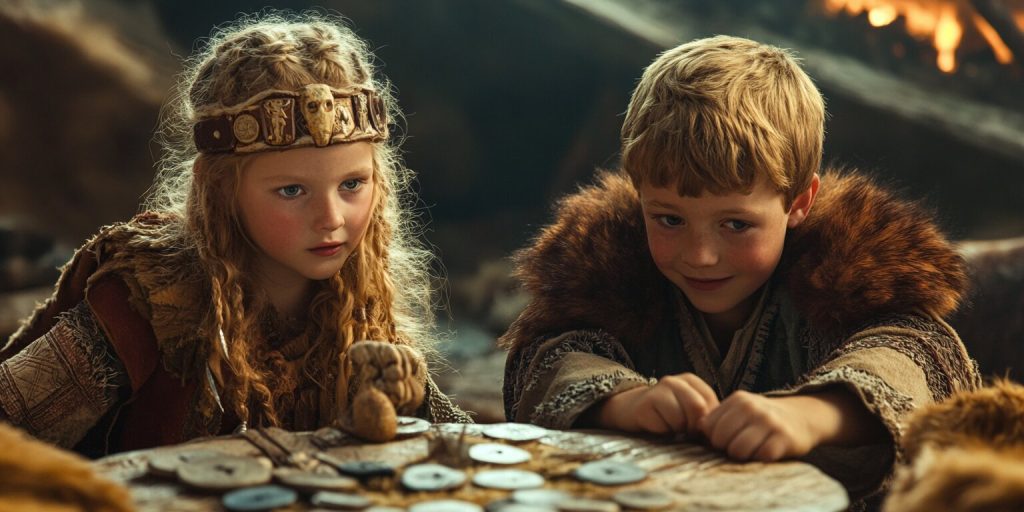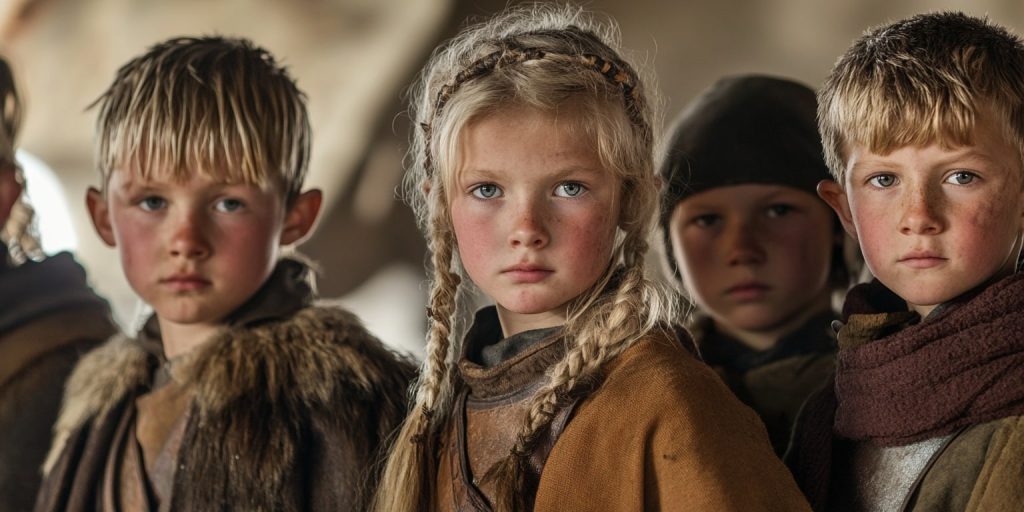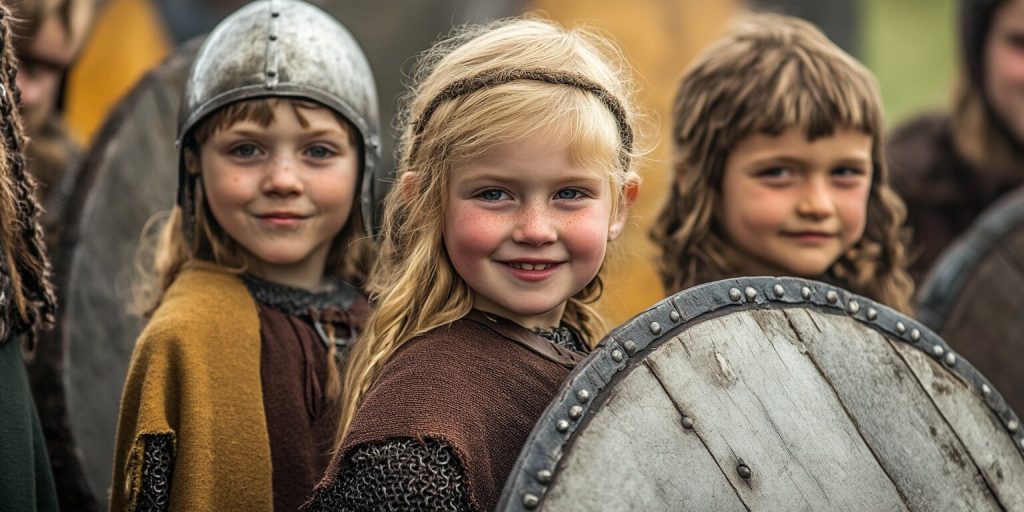Daily Life in the Viking Age, Vikings
Did Vikings Care For Their Children?
Vikings are often seen as fierce warriors, but they were also caregivers. In a culture of raids and exploration, they didn’t ignore their children, recognizing that children played a vital role even in the Viking Age. Instead, Viking kids were an important part of Norse society.
They received strong quality primary care, which was key to family life. We’ll examine how Viking children grew up, including their parents’ roles and society’s impact. We’ll use archaeology and history to show how Vikings valued raising their kids.
The Life of a Viking Child
Viking children’s lives were filled with play, learning, and helping. They started learning important skills early, preparing them to like to be a Viking. These skills helped them grow into useful members of Viking society.
Daily Routines and Responsibilities
Viking kids had to help their families every day. They did things like:
- Helping with household chores
- Taking care of little siblings
- Helping with farming and animals
- Gathering wood and keeping fires going
These tasks taught them discipline and teamwork. It showed how important each child was to the family. It helped them prepare for bigger roles later, fostering a sense of responsibility in Viking boys.
Integration into Viking Society
Being part of Viking society was vital for kids. From a young age, they participated in community events and worked. This helped them make friends and learn about Viking traditions.
- Attending festivals and seeing crafts
- Going on fishing and hunting trips was a rite of passage for Viking boys and girls.
- Listening to stories from the elders was an important part of Scandinavian children’s upbringing.
This helped them better understand the world and prepared them for adulthood. Viking kids learned essential skills through these experiences.
Viking Family Structure
The Viking family structure was complex and key to raising children. It showed how mothers and fathers worked together to care for children. The extended family also played a big role in building a strong sense of community.
The Roles of Mothers and Fathers
In the Viking era, mothers and fathers had clear but matching roles. Mothers took care of the home, handling daily tasks and keeping the family running smoothly. They taught children important skills like cooking and weaving.
Fathers, meanwhile, worked outside the home. They were involved in trade, farming, and warfare, activities that shaped the lives of Scandinavian children. Their jobs helped support the family and taught children about responsibility.
Extended Family’s Importance
The extended family was essential in Viking society. Relatives like grandparents and aunts helped raise the children, so kids learned from many people.
They learned about social norms, values, and survival skills, which helped keep Viking traditions alive. The extended family gave the kids emotional and educational support, helping them grow in a rich cultural setting typical of Scandinavian childhood.
Childhood in the Viking Age
Childhood in the Viking Age was full of fun and learning, allowing children to grow into capable Viking boys and girls. Viking kids played many games that were both fun and educational, helping them learn important skills for later life.

Play and Recreation Among Viking Children
The play was key for Viking kids. They loved playing outside, running races, and even pretending to fight. These games helped them stay fit and work together.
Learning Through Play: Traditional Games and Toys
Games were a big part of Viking kids’ lives. They played board games made from wood and clay. These games taught them about strategy and competition, skills essential for Viking boys.
Toys were also important. They were made from wood, clay, and more, showing Viking kids’ creativity. Each toy and game helped them learn and have fun at the same time.
Viking Children and Education
Education was vital for Viking children as they prepared for adulthood. They learned important trades like carpentry, farming, and navigation. This hands-on learning helped them grow into independent and skilled adults.
Importance of Skills Development
Viking kids learned by doing real tasks. They got training in survival and growth skills. Key areas included:
- Farming to feed families.
- Shipbuilding and navigation for exploration and trade.
- Craftsmanship, like making clothes and tools, was essential for survival in Scandinavia, where children could learn valuable skills.
This training prepared young Vikings for their future and taught them to care for their families and communities.
Literacy Rates Among Young Vikings
Literacy was not common among Viking children. Their culture relied more on stories than written words, yet some children from rich families could read and write.
Their education focused on stories and practical skills. Knowing how to communicate was vital for trade and talks between settlements.
Even with low literacy rates, Viking kids were well-prepared for life. They learned important skills that helped them grow into capable adults.
Health and Mortality Rates of Viking Children
Children in the Viking Age faced big health challenges. High mortality rates changed family and social structures. Harsh living and little medical knowledge led to many child deaths.
Child Mortality in Norse Society
Child death rates in Norse society were very high. This was mainly due to diseases and not enough food. Many Viking babies died from these problems, causing great fear in families.
Common Health Issues Faced by Viking Children
Viking kids had to deal with many health problems. Some common issues were:
- Infections like breathing problems and diarrhea
- Parasitic diseases from bad sanitation
- Not enough food because of limited resources
These health issues made Viking children very vulnerable. They showed how hard it was for families to keep their kids healthy back then.
Viking Children and Household Chores
Viking kids played a big role in doing household chores early on. These tasks were not just jobs but also lessons for the future. They helped shape what boys and girls could expect in life.
Responsibilities from a Young Age
Even when they were young, Viking kids had to help out at home, as children would often take on responsibilities from an early age. Their work helped the family and taught them to be responsible. Some common tasks included:
- Animal care, including feeding and milking
- Gathering firewood and maintaining the hearth
- Assisting with food preparation
- Cleaning and organizing their living spaces
These early tasks gave them skills for when they grew up.
Gender Roles in Household Tasks
Gender played a big part in who did what chores. Boys did harder tasks like:
- Hunting and fishing
- Building and repairing structures
Girls did more domestic work, like:
- Weaving and sewing clothing
- Caring for younger siblings
- Preparing meals
This way of dividing work taught kids their future roles, helped shape who they would become, and supported Viking culture.
Viking Burial Practices for Children
Viking burial practices for children give us a peek into their values and beliefs. These practices show how Vikings viewed life and death and highlight the importance of young lives in their culture.
Cultural Significance of Child Burials
In Viking society, burying children was very special. It showed the strong bond between parents and kids. Families placed important items to the child in the grave, hoping for a good afterlife.
This shows that Vikings understood the challenges of childhood and that they had deep love and grief for their children.
Archaeological Finds Related to Viking Childhood
Recent digs have uncovered a lot about Viking children’s burials. Graves often contained toys, clothes, and other personal items, which shows how much Viking families loved their children.
Things like wooden figures and small tools were found with the remains. These finds help us understand what childhood was like in Viking times.
The Role of Vikings in Daycare and Childcare
Viking culture valued community in raising kids, emphasizing the importance of a collective effort in nurturing Scandinavian children. Families worked together, not alone. This way, kids got the care they needed while parents did other things.

Community Involvement in Child Raising
In Viking settlements, daycare was part of daily life as a Viking. Neighbors and relatives watched the kids, making them feel safe and loved. This helped kids learn from many adults, teaching them important social skills.
Support Systems within Viking Settlements
Viking support systems were vital for childcare. Families were close, making sure kids were always cared for. Elders gave advice and watched over kids, helping mothers with work and ensuring that children could learn from their wisdom.
This teamwork showed how important it was to raise kids together. It helped the whole community grow strong.
Viking Myths and Legends About Children
Myths and legends are key parts of Viking culture. The stories that shaped their Nordic identity often feature children as heroes, demonstrating the importance of children in these stories. The Icelandic sagas, a big part of Norse literature, often feature children as key figures in the stories of Scandinavian heritage.
These stories show children as symbols of innocence, potential, and family lines. They reflect what society believed about the future and qualities of the young. This makes a rich story that shows how important children and childhood were in Viking society.
Representation of Children in Icelandic Sagas
Children in Icelandic sagas carry wisdom and moral lessons. They show courage, loyalty, and resilience. Legends tell of children doing brave acts or showing great wisdom.
This makes them important in the community, as children would grow up contributing significantly to Viking society. It shows that the Viking culture saw children as future leaders and influencers.
Superstitions and Beliefs Around Viking Children
Superstitions and beliefs shaped how Viking children were raised. Parents performed rituals to keep their children safe from harm. They believed some natural things could protect children and their childhood while others could harm them.
These beliefs guided how parents raised their kids. Viking culture saw children as vulnerable and crucial to the community’s future.
How Viking Children Became Adults
Their culture shaped Viking children’s journey to adulthood. As they grew, they learned the skills and traditions of their society. This prepared them for their roles in the community.
Transitioning from Childhood to Adulthood
As they grew older, Viking children faced many experiences. These experiences taught them practical skills and social values. They helped with household chores, learned trades, and strengthened themselves through physical activities.
Rites of Passage in Viking Culture
Rites of passage were key in Viking culture. Ceremonies like taking an oath or going on hunts marked a child’s transition. These rites strengthened social bonds and taught important lessons.

